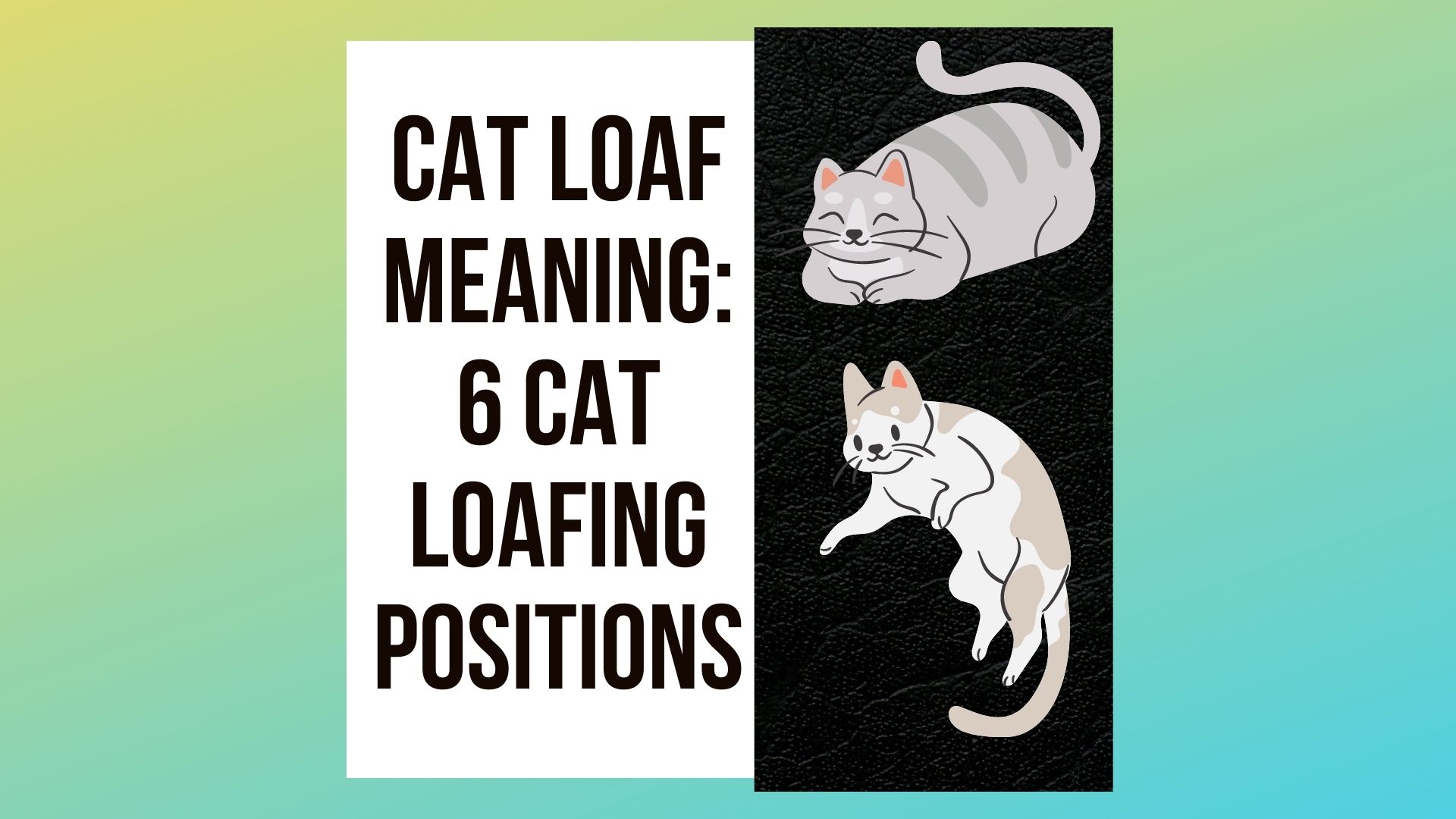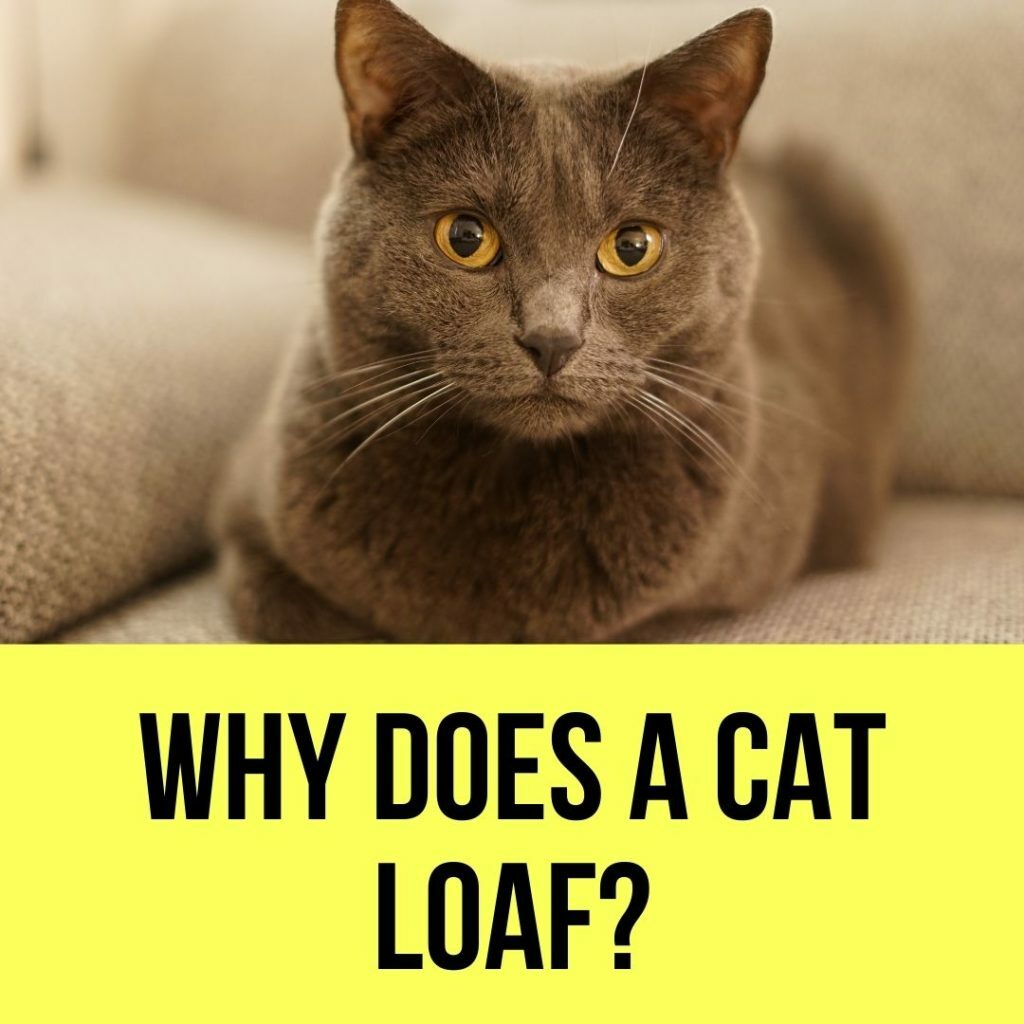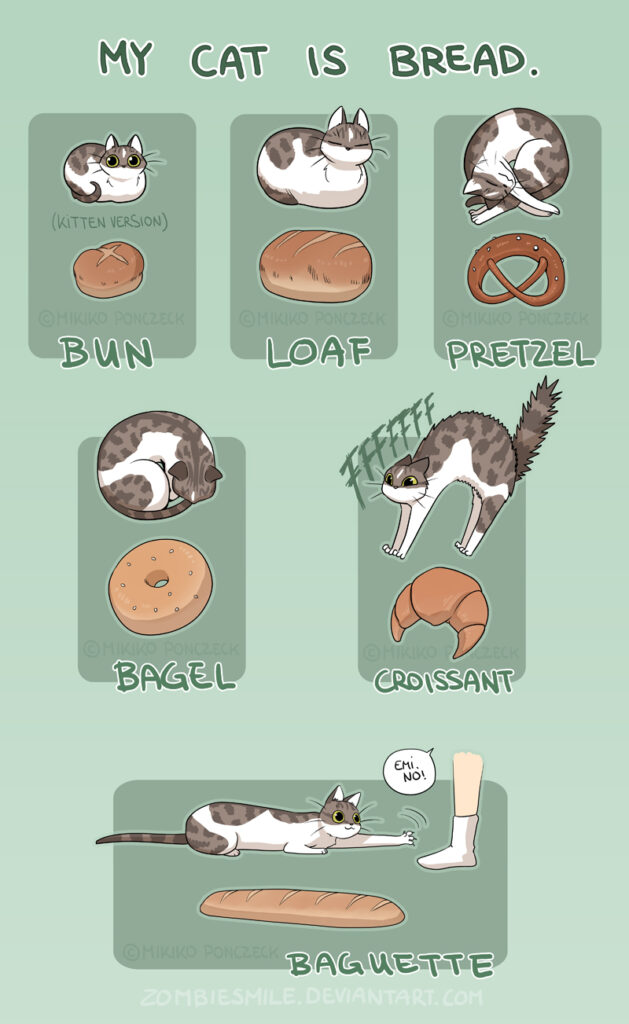
Why Do Cats Loaf? What Does Cat Loaf Mean?
Cat loafing is a position where the feline tucks her tail and legs under her body. It often resembles a loaf of bread.
It is a very common position in felines. In most cases, it indicates that the cat is comfortable or relaxed.
If you have not heard of a cat loaf, maybe you are more familiar with terms like potato cat, hover cat, or turkey cat. It is a universal cat pose.
What does it mean when a cat is loafing?
Usually, felines take this position when they are feeling comfortable. Felines can loaf around, but you will mostly find them in their favorite spots. Many experts suggest that, in a loaf position, all the claws are hidden. This means that the feline is feeling safe and doesn’t sense any danger.
However, it does not mean that they are fully relaxed like when they are belly up. The feline loaf position makes the felines rest comfortably while staying alert for everything.
But, the truth is, cat owners can never be sure of what the feline loaf means. It can be different with every cat. We can only observe and try to understand our felines as much as possible.

6 Cat loaf positions
There are different variations in cat loaf positions. These variations include:
- Partial cat loafing
If you can see the sides of your kitty’s paws while in the loaf position, it is known as a partial loaf. The claws are not tucked under all the way. It looks as if they are wrapped around the chest.
- Sphynx cat loafing
This one is the regular loaf position, but your feline will have her paws stretched in front of her. The Egyptian Sphynx monument is the inspiration behind this name.
- Meatloaf position
Instead of having an upright head, in this position felines have hunched backs. Also, they will lean forward with their head toward the ground.
- Attack loafing
Your feline’s paws are stretched, the back legs are ready to jump, and the eyes are alert. The tail point outward.
- Bread loaf position
“Loaf position” is when a cat sits with its paws tucked underneath it, like a bread loaf. Cats can’t speak, so body language is one of the best ways to gauge their mood.
There are many possible explanations for cats’ behavior. One is that they want to make themselves look more adorable
Bread Loaf is Like Bun, bagels, Croissant, baguettes, and pretzels

- Crouching Semi-Loaf
Cats have a less-relaxed position when they sleep called loafing. Cats might crouch, with their front paws out in front of them or flat on the ground beneath them, or even sleep while sitting up. This is an alert and ready position in case there is an intruder nearby.
Some More Cat Positions
- Basic Tight Curls
Cats typically sleep in the curl position and this can help them stay warm, be more difficult to spot, and easy to jump from. Cats sometimes put a paw over their eyes when sleeping like this to block out light.
When you are near your cat, she’ll crouch into a tight ball with her belly exposed. She’s telling you through her body language that she’s happy to see you. But just be careful with the belly rub – cats don’t generally enjoy that as dogs do.
- Side Sleeping
If your cat has a “fever,” it could mean he’s trying to cool off. If you’re outside during the day, your cat might retreat to the concrete in the shade and lie in this position to cool down.
You’ll often see cats lying like this on the tile in your home if they get a little overheated. Make sure your kitty has plenty of water, and you might even consider turning down your AC so the house is a little cooler.
- Monorail
Cats can sleep in many different positions, and they are often comfortable and safe in their chosen position. This can include hanging on a couch arm or sleeping up a tree.
- Snuggling Up (You & Other Cats)
If your cat buries into your lap during the day or sleeps next to you at night, then you’re one lucky cat owner.
This is typically a sign of love and trust. If it is also cold outside, you might notice that your cat will sleep next to you more often.
- Head Press Position
Some cats sleep with their head pressed down on the ground in front of them, and sometimes this is just to block out light.
Cat Sitting Like a Loaf Meaning
- Loafing positions is Comforting them
- Loaf provides Safety for Cat
- Cat is Conserving Body Heat [Thermoregulation]
- Cat’s Paw has some Injury
- Disease or Sickness
- It’s just they are acting like a Brat
- Trying to Gain Attentions By Doing such acts
Why does my cat loaf and stare at me?
Your cat feels safe
It may appear peculiar and mysterious when cats take a seat down with their paws and tail tucked under them. However, this is a totally common sitting position for cats and it means that they feel secure and comfortable. In fact, this is the most common cause of loafing.
Think about it – for felines in the wild, their paws are their first line of protection against predators. They need the paws and claws to lash out if any risky animals come close by to scare them away.
If a threatening scenario does develop, cats can even need the paws at hand so they can quickly get up and run.
By sitting with their paws tucked below them, your feline is at its most vulnerable state. If any threat was close by, they would have a more difficult time protecting themselves.
Therefore, felines will most effectively sit in the conventional loaf position when confident they’re absolutely safe.
When a cat does feel comfortable and safe, the loaf position will look like this:
- Head stays upright
- Tucks the paws under the body
- Looks calm and comfortable
- Ears do not move a lot
- Shuts eyes completely
- Eyes are opening and closing slowly
- The tail surrounds the body
- Whiskers are calm
Your feline has a paw injury
Although the cat loaf is mostly a great sign, it can additionally be an indication that your feline has injured her paws.
Tucking them below the body is her manner of protecting them from similar harm.
Besides, the moderate stress from their tummy pressing down on their paws may also assist with any pain they’re feeling.
Paw injuries are pretty common in cats and consist of:
Stings:
Other animals that may have attacked your cat include bees, wasps, scorpions, or nettles. This is often visible in outdoor cats who’re much more likely to encounter those animals and plants.
Most stings end up inflamed as part of the immune response and cause irritation, specifically if there is more than one bite or stings.
Ingrown Nails:
If your feline’s nails grow too long, they’ll ultimately grow inwards closer to their paw pads. This is much more likely in long-haired breeds including Maine Coons or Persians as their lengthy claws can go neglected until after the harm is done.
Sharp Objects:
It is likewise possible that your feline steps on a pointy item and cuts open her paw. This can cause bleeding and an open wound that would end up getting infected, or the pointy item can be lodged into their paw pad. Examples consist of glass and thorns.
Fractures:
Your feline can fracture the bones in her paws both by jumping from an excessive height or by a heavy item falling on them.
Cats are masters at hiding aches.
So, it can be tough to tell whether or not your kitty is in the loaf position due to an injury or wound. However, there are symptoms that you could look out for.
If your kitty is regularly licking one of her paws before and after taking the loaf position, this can be a signal that there may be an injury or wound there.
The feline is feeling too cold
There is likewise the possibility that your feline is loafing as a way of temperature control.
The core body temperature for pussycats is an average of 101.5 degrees Fahrenheit. This is the ideal temperature for all the organs and physical processes to feature effectively, and so felines will try and hold their bodies at this temperature irrespective of the climate outside or the temperature of the house.
In a colder climate, your kitty will keep themselves warm by curling up and retaining their extremities near their bodies. Doing so will restrict the quantity of heat lost and make it simpler for them to stay warm.
It is comparable to someone moving into the bed and pulling the covers up to their chin on a chilly winter’s day. They experience cushy and heat.
The loaf position is the ideal position for preserving as a whole lot warmness as possible. A feline’s paws lose most of the warmth. This means that they’re commonly one of the first places to experience cold.
However, cats tuck their paws tightly beneath their tummies, and they experience heat and comfort. Their tail wrapping tightly around their bodies, in addition, facilitates thermoregulation.
So, in case your cat’s surroundings aren’t warm enough, she is probably feeling cold and looking to maintain its body heat by taking the loaf position.
Your feline is ready to pounce
In a few instances, in particular when felines are outside and surrounded by butterflies, insects, and other animals, or whilst they are playing with you, felines may take another loaf position: the attack loaf.
This loaf position is different from the other loaf positions. The front paws are generally in the open in front of them. And the head rests on their paws.
While withinside the attack loaf position, their tail is generally pointing outwards. However, sometimes it could additionally be by their side.
Other things that you may look out for to distinguish this position from the other cat loaf stances include:
- Eyes are alert and wide
- Doesn’t appear sleepy or lazy
- The back legs are ready for jumping
- The tail points out
- The front paws are stretched
The kitty has chronic kidney disease
As referred to above, there’s a whole lot of the loaf position known as the meatloaf function.
This pose seems visibly one of a kind from the conventional loaf, partial loaf, or Sphynx loaf. Their back could be arched upward, looking contorted and uncomfortable.
Their weight will shift forwards and their nostril will point toward the floor. You will additionally notice that their eyes are clenched shut as though they’re in pain.
This sort of pose isn’t always a great sign, and it’s far a common sleeping position for the extraordinarily sick kitties that are suffering from chronic kidney disease (CKD). This is where the kidneys stop functioning efficiently and it’s far very painful for felines. It is more common in senior felines over the age of seven. However, can arise in felines of any age.
To apprehend the consequences of CKD, we first need to understand the function of the kidneys. Just as in humans, a feline’s kidneys are responsible for numerous critical physical functions, including:
- Prevents dehydration
- Produces hormones for RBC production
- Clear out and remove toxins from the body
The feline is lethargic
If your feline takes the loaf position more frequently than usual, this can be a signal that your feline is missing its ordinary amount of energy, referred to as lethargy.
When in the loaf position, felines will frequently act sleepy and start napping.
Cats typically do not sleep long and deeply in the loaf position. However, they may have a mild sleep. If your feline hears a sound, it’ll open its eyes and check out what is happening. And, if what your furball sees is worth its attention, then it’ll straight away move out of the loaf position.
Final words
In conclusion, the cat loaf is a completely common function that should not fear you at all. In maximum cases, your feline takes this position whilst there’s no need to use its paws and it feels secure and comfortable.
If your cat is this stress-free around you, that’s a great signal they may be happy.
Your cat may also be tucking their paws beneath their body to assist maintain its warmth or to get fine and relaxed for its nap.
Or possibly your kitty has sustained a paw injury and is making an attempt to maintain its sore paws out of harm’s way.
You have to easily be capable of noticing this by looking for symptoms of limping or analyzing their paws.
I hope you enjoyed the article. We will be back soon. Till then, stay connected. Thank you
- Pairing Off: Are My Cats A Bonded Pair?
- Why Are Cats Afraid of Water?
- How to Tell When a Cat is Ready to Give Birth?
Frequently asked questions
Do cats feel love when you kiss them?
Some felines do like human kisses. If your kitty leans in, rubs her head, and purs when you kiss her, she may know that you are showing affection.
Do fixed male cats still hump?
Humping is normal for sexually intact male cats. Even after the castration surgery, it will take time for the hormones to leave. Also, it is not unusual for mounting to continue for around a few weeks.
What does cat loafing convey?
Cat loafing is a term used to describe a cat’s sitting position in which her tail and paws are tucked under her body. This formation seems like a loaf of bread. Hence, it is usually known as cat loaf.
Cat loafing with head down
Being exhausted is the prime reason for cat loafing with head down. She is so tired that she cannot be bothered to curl up in a comfortable position. Instead, she faceplants and flops down immediately.

Hi, This is Alexa, and I love cats. This Website is a Complete Journal about how to travel with a cat and other information about Cat Health, Cat Training, Cat Behavior, Cat Foods and more. I hope you find it useful.
